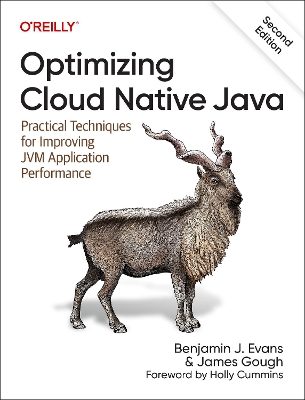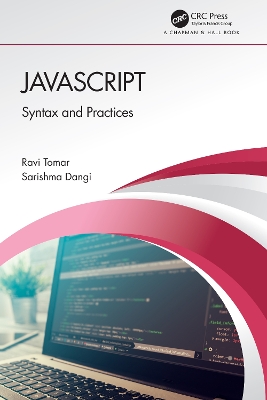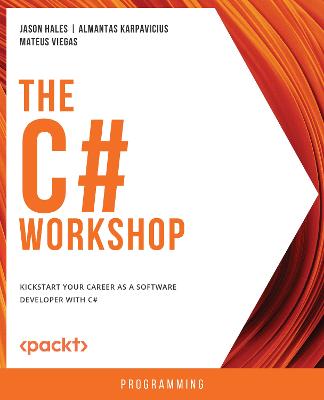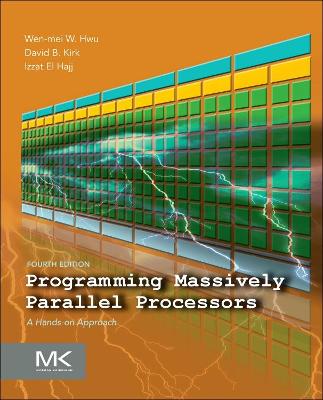C Programming
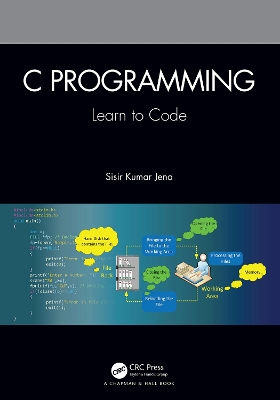 portes grátis
portes grátis
C Programming
Learn to Code
Jena, Sisir Kumar
Taylor & Francis Ltd
10/2024
428
Mole
9781032036274
Pré-lançamento - envio 15 a 20 dias após a sua edição
Descrição não disponível.
1 Introduction to Computer. 1.1 Introduction. 1.2 Definition and Characteristics of a Computer System. . 1.3. History of Computer. . 1.4 Basic Computer Organization. 1.5 Computer Memory. 1.6 Introduction to Operating System. 1.7 Review Questions. 2 Number System. 2.1 Introduction. 2.2 Positional Number System. 2.3 Number Conversion. 2.4 Review Questions. . 3 Problem Solving through Flowchart and Algorithm. 2.1 Introduction. 2.2 Problem Solving Approach. 2.3 Algorithm Design. 2.4 Basics of an Algorithm. 2.5 Flowchart. 2.6 Example Problems. 2.7 Basics of Programming Language. 2.8 Review Questions. . 4 Introduction to C Programming. 4.1 Introduction. 4.2 History of C. 4.3 Executing a C Program. 4.4 Structure of a C Program. 4.5 Compilers and Editors to Execute C Program. 4.6 Review Questions. . 5 Constants, Variables, and Data Types. 5.1 Introduction. 5.2 C Character Set. 5.3 Keywords. 5.4 Variables and Identifiers. 5.5 Data Types. 5.6 Declaration of Variables. 5.7 Constants. 5.8 Learn to Code Examples. 5.9 Escape Sequences. 5.10 Review Questions. . 6 Operators and Expressions. 6.1 Introduction. 6.2 Arithmetic Operator. 6.3 Relational Operator. 6.4 Assignment Operator. 6.5 Logical Operator. 6.6 Increment and Decrement Operator. 6.7 Conditional Operator. 6.8 Bitwise Operator. 6.9 Special Operators. 6.10 Expressions. 6.11 Type Conversion. 6.12 Operator Precedence and Associativity. 6.13 Review Questions. . 7 Basic Input Output. 7.1 Introduction. 7.2 Unformatted Functions. 7.3 Formatted Functions. 7.4 Review Questions. . 8 Control Structure. 8.1 Introduction. 8.2 Selection with if statement. 8.3 if-else Statement. 8.4 Nested if-else Statement. 8.5 If-else-if Ladder. 8.6 Compound Statement. 8.7 Multiway Selection with switch Statement. 8.8 goto Statement . 8.9 Introduction to Looping. 8.10 while Loop. 8.11 do-while Loop. 8.12 for Loop. 8.13 Unconditional branching: break and continue. 8.14 Review Questions. . 9 Function. 9.1 Introduction. 9.2 Need of functions. 9.3 Types of Function. 9.4 User Defined Function. 9.5 Component and Working of a Function. 9.6 Categories of a Function. 9.7 Recursion. 9.8 Storage Classes. 9.9 Review Question. . 10 Arrays and Strings. 10.1 Introduction. 10.2 Need of an Array. 10.3 Types of Array. 10.4 One Dimensional Array. 10.5 Two Dimensional Array. 10.6 Multidimensional Array. 10.7 Character array: String. 10.8 String Functions. 10.9 Review Questions. . 11 Pointers. 11.1 Introduction. 11.2 Basic Knowledge. 11.3 Pointer Variable. 11.4 Pointer to Pointer (Double Pointer). 11.5 Void Pointer. 11.6 Null Pointer. 11.7 Constant Pointer. 11.8 Pointer Arithmetic. 11.9 Pointers and Functions. 11.10 Pointers and Arrays. 11.11 Passing Arrays to Function. 11.12 Pointers and Two Dimensional array. 11.13 Pointer and String. 11.14 Arrays of Pointers. 11.15 Pointers to Function. 11.16 Review Questions. . 12 Structure and Union. 12.1 Introduction. 12.2 Declaring Structure. 12.3 Initializing structure. 12.4 Accessing Structure elements. 12.5 Learn to Code Examples. 12.6 Array of Structures. 12.7 Structure within Structure (Nested Structure). 12.8 User defined Data Type: typedef. 12.9 Pointers and Structures. 12.10 Structure and Function. 12.11 Unions. 12.12 Structure VS Union. 12.13 Bit Fields. 12.14 Enumeration. 12.15 Review Questions. . 13 Dynamic Memory Allocation. 13.1 Introduction. 13.2 Types of Memory Allocation. 13.3 Dynamic Memory Allocation Process. 13.4 Review Questions. . 14 File Handling. 14.1 Introduction. 14.2 Basics of File I/O. 14.3 Opening a File. 14.4 Closing a File. 14.5 File Functions with Examples. 14.6 Review Questions. . 15 The Preprocessor. 15.1 Introduction. 15.2 Preprocessor Directives. 15.3 Macro Substitutions. 15.4 #include Preprocessor. 15.5 Conditional Preprocessors. 15.6 Other Preprocessor Directives. 15.7 Review Questions. . 16 Command Line Arguments. 16.1 Introduction. 16.2 Executing a Program using Command Prompt. 16.3 Fundamentals of Command Line Argument. 16.4 Using Command Line Argument. 16.5 Review Questions.
Este título pertence ao(s) assunto(s) indicados(s). Para ver outros títulos clique no assunto desejado.
Dynamic Memory Allocation;Char Str;Preprocessor Directive;User Defined Functions;Header File;Memory Allocation;Predefined Functions;Cpu Register;Char Ch;Void Pointer;Data Type;Character Array;Command Line Arguments;Prime Number;Command Prompt;Octal Number System;User Defined Data Type;Decimal Equivalent;Hexadecimal Number;Machine Language Program;Equivalent Decimal Number;Binary Number;Decimal Number;Octal Number;Int Argc
1 Introduction to Computer. 1.1 Introduction. 1.2 Definition and Characteristics of a Computer System. . 1.3. History of Computer. . 1.4 Basic Computer Organization. 1.5 Computer Memory. 1.6 Introduction to Operating System. 1.7 Review Questions. 2 Number System. 2.1 Introduction. 2.2 Positional Number System. 2.3 Number Conversion. 2.4 Review Questions. . 3 Problem Solving through Flowchart and Algorithm. 2.1 Introduction. 2.2 Problem Solving Approach. 2.3 Algorithm Design. 2.4 Basics of an Algorithm. 2.5 Flowchart. 2.6 Example Problems. 2.7 Basics of Programming Language. 2.8 Review Questions. . 4 Introduction to C Programming. 4.1 Introduction. 4.2 History of C. 4.3 Executing a C Program. 4.4 Structure of a C Program. 4.5 Compilers and Editors to Execute C Program. 4.6 Review Questions. . 5 Constants, Variables, and Data Types. 5.1 Introduction. 5.2 C Character Set. 5.3 Keywords. 5.4 Variables and Identifiers. 5.5 Data Types. 5.6 Declaration of Variables. 5.7 Constants. 5.8 Learn to Code Examples. 5.9 Escape Sequences. 5.10 Review Questions. . 6 Operators and Expressions. 6.1 Introduction. 6.2 Arithmetic Operator. 6.3 Relational Operator. 6.4 Assignment Operator. 6.5 Logical Operator. 6.6 Increment and Decrement Operator. 6.7 Conditional Operator. 6.8 Bitwise Operator. 6.9 Special Operators. 6.10 Expressions. 6.11 Type Conversion. 6.12 Operator Precedence and Associativity. 6.13 Review Questions. . 7 Basic Input Output. 7.1 Introduction. 7.2 Unformatted Functions. 7.3 Formatted Functions. 7.4 Review Questions. . 8 Control Structure. 8.1 Introduction. 8.2 Selection with if statement. 8.3 if-else Statement. 8.4 Nested if-else Statement. 8.5 If-else-if Ladder. 8.6 Compound Statement. 8.7 Multiway Selection with switch Statement. 8.8 goto Statement . 8.9 Introduction to Looping. 8.10 while Loop. 8.11 do-while Loop. 8.12 for Loop. 8.13 Unconditional branching: break and continue. 8.14 Review Questions. . 9 Function. 9.1 Introduction. 9.2 Need of functions. 9.3 Types of Function. 9.4 User Defined Function. 9.5 Component and Working of a Function. 9.6 Categories of a Function. 9.7 Recursion. 9.8 Storage Classes. 9.9 Review Question. . 10 Arrays and Strings. 10.1 Introduction. 10.2 Need of an Array. 10.3 Types of Array. 10.4 One Dimensional Array. 10.5 Two Dimensional Array. 10.6 Multidimensional Array. 10.7 Character array: String. 10.8 String Functions. 10.9 Review Questions. . 11 Pointers. 11.1 Introduction. 11.2 Basic Knowledge. 11.3 Pointer Variable. 11.4 Pointer to Pointer (Double Pointer). 11.5 Void Pointer. 11.6 Null Pointer. 11.7 Constant Pointer. 11.8 Pointer Arithmetic. 11.9 Pointers and Functions. 11.10 Pointers and Arrays. 11.11 Passing Arrays to Function. 11.12 Pointers and Two Dimensional array. 11.13 Pointer and String. 11.14 Arrays of Pointers. 11.15 Pointers to Function. 11.16 Review Questions. . 12 Structure and Union. 12.1 Introduction. 12.2 Declaring Structure. 12.3 Initializing structure. 12.4 Accessing Structure elements. 12.5 Learn to Code Examples. 12.6 Array of Structures. 12.7 Structure within Structure (Nested Structure). 12.8 User defined Data Type: typedef. 12.9 Pointers and Structures. 12.10 Structure and Function. 12.11 Unions. 12.12 Structure VS Union. 12.13 Bit Fields. 12.14 Enumeration. 12.15 Review Questions. . 13 Dynamic Memory Allocation. 13.1 Introduction. 13.2 Types of Memory Allocation. 13.3 Dynamic Memory Allocation Process. 13.4 Review Questions. . 14 File Handling. 14.1 Introduction. 14.2 Basics of File I/O. 14.3 Opening a File. 14.4 Closing a File. 14.5 File Functions with Examples. 14.6 Review Questions. . 15 The Preprocessor. 15.1 Introduction. 15.2 Preprocessor Directives. 15.3 Macro Substitutions. 15.4 #include Preprocessor. 15.5 Conditional Preprocessors. 15.6 Other Preprocessor Directives. 15.7 Review Questions. . 16 Command Line Arguments. 16.1 Introduction. 16.2 Executing a Program using Command Prompt. 16.3 Fundamentals of Command Line Argument. 16.4 Using Command Line Argument. 16.5 Review Questions.
Este título pertence ao(s) assunto(s) indicados(s). Para ver outros títulos clique no assunto desejado.
Dynamic Memory Allocation;Char Str;Preprocessor Directive;User Defined Functions;Header File;Memory Allocation;Predefined Functions;Cpu Register;Char Ch;Void Pointer;Data Type;Character Array;Command Line Arguments;Prime Number;Command Prompt;Octal Number System;User Defined Data Type;Decimal Equivalent;Hexadecimal Number;Machine Language Program;Equivalent Decimal Number;Binary Number;Decimal Number;Octal Number;Int Argc

